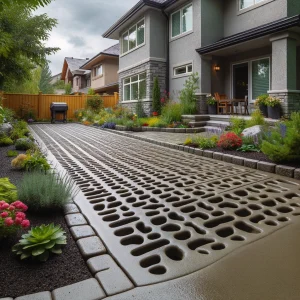As concerns about environmental sustainability continue to grow, gardeners and landscapers are increasingly seeking innovative solutions that balance aesthetics with ecological responsibility. One such solution is permeable paving, which offers a practical way to manage stormwater and reduce runoff. In this blog, we will explore various permeable paving options, their benefits, how they work, and considerations for gardeners and landscapers in British Columbia.

Understanding Permeable Paving
Permeable paving refers to various materials and techniques that allow water to pass through the surface and infiltrate the ground below. Unlike traditional impervious surfaces, such as concrete and asphalt, permeable pavements help mitigate the negative impacts of stormwater runoff, including flooding and erosion. Therefore, it is a highly effective solution for sustainable landscaping.

Types of Permeable Paving Options
Porous Concrete: This type of concrete is made with reduced fines, creating voids that allow water to pass through. It’s solid and durable, making it suitable for driveways and pathways. Consequently, it is a popular choice for residential areas.
Permeable Pavers: These units are made from concrete or stone designed to interlock with spaces between them for water infiltration. They come in various shapes and colors, providing aesthetic flexibility. Thus, they are ideal for decorative garden paths.
Gravel: Loose gravel is one of the simplest forms of permeable paving. It’s cost-effective, easy to install, and often used for pathways, driveways, and garden borders. Hence, it is a versatile option for many applications.
Porous Asphalt: Like permeable concrete, porous asphalt allows water to percolate through the surface. It’s often used in larger applications like parking lots but can be adapted for residential use. Accordingly, it is a robust solution for extensive areas.

Benefits of Permeable Paving
Stormwater Management: Permeable pavements reduce runoff by allowing water to seep into the ground, helping to prevent flooding and erosion. Consequently, they are crucial for effective stormwater management.
Water Quality Improvement: As water infiltrates the pavement, pollutants are filtered out, improving groundwater quality. Therefore, permeable pavements contribute to cleaner water systems.
Reduced Heat Island Effect: Permeable surfaces can reduce the heat island effect common in urban areas, as they absorb and release heat more gradually than traditional pavements. Thus, they help mitigate urban heat issues.
Aesthetic Appeal: With various design options available, permeable paving can enhance the visual appeal of gardens and landscapes. Hence, they offer both functional and aesthetic benefits.

How Permeable Paving Works
Permeable paving systems are typically installed over a bed of aggregate materials that help drainage. Water passes through the surface, is filtered by the aggregate, and slowly infiltrates the soil below. Consequently, this process mimics natural hydrology, reducing the burden on stormwater systems. Therefore, it is an efficient way to manage water flow.

Regional Considerations in British Columbia
Due to the region’s heavy rainfall, managing stormwater is particularly important in British Columbia. Permeable paving can solve urban and suburban settings where traditional impervious surfaces contribute to significant runoff issues. Moreover, local regulations may also incentivize permeable pavements to promote sustainable urban development. Thus, understanding regional needs is essential.

Selecting the Right Permeable Paving Solution
Garden Paths and Walkways: Gravel or permeable pavers are ideal for areas with light foot traffic. They provide a natural look and are easy to maintain. Hence, they are suitable for aesthetic garden paths.
Driveways: Permeable concrete or pavers are better suited for driveways due to their durability and load-bearing capacity. Therefore, they offer a practical solution for residential driveways.
Public Parks and Recreational Areas: Porous asphalt or permeable pavers can be used for larger areas, balancing functionality and aesthetics. Consequently, they are excellent for public spaces.

Maintenance Considerations
While permeable pavements require less maintenance than traditional surfaces, they are not entirely maintenance-free. Regular cleaning to remove debris and prevent clogging is essential to maintain permeability. For pavers, periodic re-sanding may be necessary to ensure stability and water infiltration. Thus, a maintenance plan is crucial.
Environmental and Economic Impact
Permeable paving contributes to environmental sustainability by reducing runoff, improving water quality, and mitigating urban heat islands. Economically, the initial investment may be higher than traditional paving, but the long-term benefits, including reduced flood damage and lower stormwater management costs, make it a worthwhile consideration. Therefore, the overall impact is significant.

Potential Challenges
Clogging: Porous surfaces can become clogged with dirt and debris over time, reducing their effectiveness. Regular maintenance is crucial. Hence, a proactive approach is necessary.
Installation Costs: The upfront cost of permeable paving can be higher than traditional options. However, it can be cost-effective considering the long-term benefits and potential regulatory incentives. Thus, the initial investment should be viewed in context.
Permeable paving solutions offer a sustainable alternative to traditional paving methods, providing significant environmental benefits while enhancing the aesthetic appeal of gardens and landscapes. For gardeners and landscapers in British Columbia, understanding the options and considerations involved can help select the right solution to manage stormwater effectively and reduce runoff. Therefore, embracing permeable paving is a step toward more sustainable and resilient landscape practices.